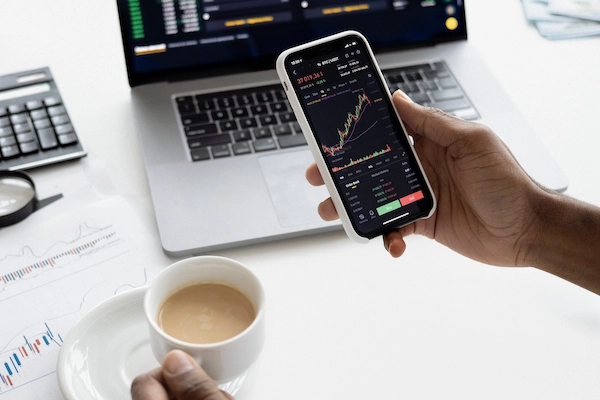Physical Gold Vs Paper Gold – Basic Differences

So, what are the differences between physical gold vs paper gold?
Investing in gold has long been considered a reliable hedge against economic uncertainties and a means of preserving wealth.
However, when it comes to investing in gold, there are two main approaches to consider: physical gold and paper gold. Physical gold refers to tangible metal in the form of bars, coins, or jewelry, while paper gold encompasses various investment instruments that represent ownership or exposure to gold without physical possession.
Each approach carries its own set of advantages and considerations, making the choice between physical gold and paper gold an important decision for investors.
In this discussion, we will explore the key differences between these two investment methods, examining factors such as ownership, tangibility, storage, liquidity, costs, and risks. By understanding the distinctions between physical gold and paper gold, investors can make informed decisions to align their gold investment strategy with their specific goals and preferences.
Physical Gold

Physical gold refers to the actual metal in the form of bars, coins, or jewelry that investors can purchase and physically hold.
It has been valued for centuries as a reliable store of wealth and a hedge against inflation and economic uncertainties. Physical gold offers several advantages and considerations for investors.
Advantages of Physical Gold
Tangible Asset
Physical gold provides investors with a tangible and durable asset. Holding a physical piece of gold can provide a sense of security and stability, as it is not dependent on electronic systems or financial institutions.
Intrinsic Value
Gold has intrinsic value due to its scarcity and unique properties. It is widely accepted and recognized as a form of currency or wealth across the world. The demand for gold remains relatively stable, making it a desirable asset for long-term wealth preservation.
Portfolio Diversification
Including physical gold in an investment portfolio can help diversify risk. It has historically demonstrated a low correlation with other asset classes such as stocks and bonds. And it can potentially enhance portfolio stability during times of market volatility.
Privacy and Independence
Owning physical gold provides a level of privacy, as transactions can be conducted outside of the formal financial system. It allows individuals to maintain a degree of independence from banks, governments, and other financial intermediaries.
Disadvantages of Physical Gold
While physical gold has its advantages, there are also some considerations and potential drawbacks to keep in mind:
Storage and Security
Physical gold necessitates proper storage and security measures. Investors must ensure that their gold is kept in a safe and secure location, such as a home safe or a trusted vault. This requirement for secure storage can result in additional costs and logistical considerations.
High Premiums
When purchasing physical gold, investors often pay premiums above the spot price. These premiums account for various factors, such as manufacturing, distribution, and dealer costs.
The premiums can reduce the immediate value of the investment and increase the breakeven point for future sales.
Illiquidity
Selling physical gold can sometimes be a more cumbersome process compared to liquidating paper gold. Finding a buyer, negotiating a fair price, and ensuring the authenticity and quality of the gold can take time and effort.
Additionally, the illiquid nature of physical gold may lead to potential delays when seeking to convert it into cash.
Paper Gold

While physical gold offers the tangible appeal of owning the precious metal directly, paper gold provides an alternative way to gain exposure to gold without the need for physical possession.
Paper gold refers to various investment instruments that represent ownership or exposure to gold through financial contracts, certificates, or exchange-traded products.
Advantages of Paper Gold
Investing in paper gold offers several advantages that may appeal to certain investors
Easy to Buy and Sell
Paper gold instruments, such as gold exchange-traded funds (ETFs) or futures contracts, provide ease of trading. Investors can buy or sell these instruments through brokerage accounts or online platforms, similar to other financial assets.
This convenience allows for quick and efficient transactions, enabling investors to take advantage of market opportunities.
Low Premiums
Unlike physical gold, paper gold often incurs lower premiums. Purchasing paper gold does not involve costs associated with fabrication, distribution, or dealer markups. The relatively low premiums make it more cost-effective for investors to gain exposure to gold’s price movements.
Diversification
Paper gold offers a way to diversify investment portfolios. By investing in gold-related financial instruments, investors can access the potential benefits of gold’s performance without allocating significant funds to physical gold. This diversification can help mitigate risk and balance the overall portfolio.
Disadvantages of Paper Gold
While paper gold has its advantages, there are also some considerations and potential drawbacks to be aware of:
Counterparty Risk
Paper gold investments carry counterparty risk. Investors are reliant on the financial institutions or issuers of these instruments to fulfill their obligations.
If the issuer faces financial difficulties or fails to meet its commitments, there is a risk that the investment may be impacted or become inaccessible.
No Ownership of Physical Gold
Unlike physical gold, investing in paper gold does not grant ownership of the physical metal. Investors hold shares, certificates, or contracts that derive their value from gold.
While this may be preferable for some, others may miss the tangible nature and sense of security that physical gold provides.
Price Discrepancies
Paper gold may not always perfectly track the price movements of physical gold. Factors such as management fees, tracking errors, or deviations from the spot price can lead to price discrepancies.
These discrepancies can affect the overall performance and alignment with the actual gold market.
Price and Value Comparison

When comparing physical gold and paper gold, it is essential to consider the aspects of price and value. While both forms are influenced by the price of gold, there are differences in how prices are determined and the underlying value they represent.
Physical Gold
Price Determination
The price of physical gold is primarily driven by supply and demand factors in the physical market. It is influenced by factors such as mining production, jewelry demand, central bank buying, and investor sentiment.
Value Representation
Physical gold carries intrinsic value due to its rarity, historical significance, and industrial uses. The value of physical gold is derived from its tangible qualities, making it desirable for its inherent properties.
Paper Gold
Price Determination
Paper gold prices are typically derived from the underlying spot price of physical gold. However, additional factors such as market sentiment, trading volume, and market maker activities can impact the price of paper gold.
Value Representation
Paper gold represents a financial claim or exposure to the price of physical gold. Its value is based on the market’s perception of the gold’s future price movements and the performance of the investment instrument itself.
It’s important to note that price discrepancies can occur between physical gold and paper gold due to various factors, including supply and demand dynamics, market sentiment, and transactional costs associated with each form.
Market Trends and Performance

Understanding the market trends and performance of physical gold and paper gold can help investors assess their potential returns and risk profiles. Here are some key considerations:
Physical Gold
Long-Term Performance
Physical gold has historically demonstrated long-term value appreciation and has often acted as a hedge against inflation and economic uncertainties. Its performance can be influenced by global economic conditions, geopolitical factors, and investor sentiment.
Market Dynamics
Physical gold markets can experience periods of price volatility driven by factors such as changes in interest rates, currency fluctuations, and investor demand for safe-haven assets.
Paper Gold:
Tracking the Gold Price
Paper gold instruments, such as gold ETFs and futures contracts, aim to track the price of physical gold. However, there may be slight deviations due to factors such as management fees, tracking errors, and market conditions.
Market Efficiency
Paper gold markets generally offer high liquidity and efficiency, allowing investors to buy and sell quickly. The performance of paper gold can be influenced by broader market trends, investor sentiment, and the overall functioning of financial markets.
Factors to Consider When Choosing Between Physical Gold and Paper Gold
When deciding between physical gold and paper gold as investment options, several important factors should be considered to align with individual financial goals and preferences. These factors include:
Personal Financial Goals and Risk Tolerance
Determine your specific financial goals, whether they involve wealth preservation, long-term capital appreciation, or portfolio diversification.
Assess your risk tolerance, understanding how comfortable you are with potential fluctuations in the value of your investment.
Time Horizon for Investment
- Consider your investment timeframe, whether it is short-term, medium-term, or long-term.
- Physical gold is often seen as a long-term store of value, while paper gold may provide more flexibility for short-term trading or investment horizons.
Diversification within a Larger Investment Portfolio
- Evaluate how physical gold or paper gold fits into your overall investment portfolio.
- Determine the desired level of diversification and the role gold will play in mitigating risk and enhancing portfolio stability.
Consideration of Market Conditions and Price Trends
- Stay informed about market conditions, including factors influencing the price of gold, such as economic indicators, geopolitical events, and monetary policies.
- Analyze price trends and the historical performance of both physical gold and paper gold to identify potential opportunities or risks.
FAQs

1. What is the risk of paper gold?
The risk of paper gold refers to the potential drawbacks or uncertainties associated with investing in paper gold instruments. Here are some risks involved: counterparty risk, tracking error, liquidity risk, etc. It’s important to understand these risks and consider them in relation to your investment goals and risk tolerance before investing in paper gold.
2. Why is physical gold more expensive?
Physical gold is typically more expensive than paper gold due to various factors. The process of mining, refining, and manufacturing physical gold involves significant costs, including extraction, transportation, refining, and storage expenses. Additionally, the limited supply and high demand for physical gold contribute to its higher price compared to paper gold.
3. Is it safe to invest in paper gold?
Deciding whether to invest in physical gold or paper gold depends on individual investment objectives, risk tolerance, and preference for owning a tangible asset. Diversifying a portfolio with a mix of physical and paper gold can be beneficial, taking into account the advantages and risks associated with each option.
Physical Gold Vs Paper Gold: Conclusion
In the fascinating world of gold investments, the battle between physical gold and paper gold rages on. While physical gold gleams with the allure of tangibility and historic value, paper gold shines with its convenience and liquidity.
As you navigate this financial landscape, remember that the decision between these two options holds the key to your investment success.
Whether you’re drawn to the lustrous allure of physical gold or tempted by the seamless trading of paper gold, tread wisely, for within these choices lie both glittering opportunities and hidden risks.
Choose your path, and let your investment journey begin, guided by the golden secrets of physical gold and the paper trails of its shimmering counterpart.
